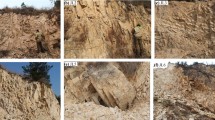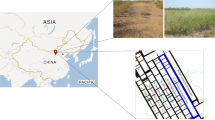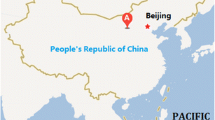Abstract
The exploitation of underground resources can lead to overburden deformation and destruction, surface subsidence with fissure development. In order to reveal the evolution laws of land damage in mining process, the paper used resistivity imaging technology to test the spatio-temporal evolution of surface soil cracks caused by underground mining. Access to land under the influence of mining damage evolution process of the whole cross-section resistivity data volume. Grasp the spatio-temporal evolution of electrical resistivity at overlying geotechnical and surface fissures during the entire mining process. The results show that: With the advance of working face, dynamic cracks in mining appear one or more “cracking–closing” processes. Dynamic fissures always develop ahead of the current working location, advance angle of break is approach to vertical angle. It indicates that dynamic fissures have fast “selfhealing” features and manual repairmen might not be necessary. Electrical resistivity imaging technology is sensitive to the change of soil micro structure. The development and failure depth of cracks in layered soil can be accurately reflected. At the same time, the deformation and failure of overlying surrounding rock caused by mining influence can also be obtained through this monitoring method. The electrical data monitoring results are basically consistent with the results obtained by actual close-range photography technology, indicating that it is feasible to use the resistivity imaging technology to monitor the evolution law of land damage caused by mining of working face. This achievement and understanding can provide technical support for the study of land ecological damage caused by coal mining.









Similar content being viewed by others

References
Chen J-H, Zhu L, Tian J (2016) Farmland soil crack distribution and its impact on soil water movement. J Irrig Drain 35(2):1–6
Cheng J-X, Nie X-J, Liu C-H (2014) Spatial variation of soil organic carbon in coal-mining subsidence areas. J China Coal Soc 39(12):2495–2500
Feng D-S, Dai Q-W, Xiao B (2014) Contrast between 2D inversion and 3D inversion based on 2D high-density resistivity data. Trans Nonferrous Met Soc China 24(1):224–232
Fu L-K (1983) Electricity exploration tutorial. Geological Publishing House, Beijing
Greve AK, Acworth RI, Kelly BF (2010) Detection of subsurface soil cracks by vertical anisotropy profiles of apparent electrical resistivity. Geophysics 75(4):85–93
Hu Z-Q, Wang X-J, He A-M (2014) Distribution characteristic and development rules of ground fissures due to coal mining in windy and sandy region. J China Coal Soc 39(1):11–18
Jin C, Liu J-P (2014) Two-dimensional numerical simulation and application of the high-density resistivitymethod. Geol Explor 50(5):0984–0990
Li C, Liu W-Z, Song X-Q (2016) Effects of mining-induced slope collapse fractures on soil moisture and vegetation in Shenfu coal mining area. Bull Soil Water Conserv 36(6):121–125
Liu M, Du W (2013) To investigate soil preferential flow paths in mountain area using dye tracer. Acta Pedol Sin 50(5):871–880
Liu Q-S, Liu K-D (2012) Characteristics of in situ stress field for deep levels in Huainan coal mine. Rock Soil Mech 33(7):2089–2096
Ma D, Zhang J, Wu Z et al (2014) Application of electrical resistivity tomography to study on soil hydrology and its advance. Acta Pedol Sin 51(3):439–447
Samouelian A, Cousin I, Richard G et al (2003) Electical resistivity imaging for detecting soil cracking at the centimetric scale. Soil Sci Soc Am J 67(5):1319–1326
Taha OME, Taha MR (2011) Cracks in soils related to desiccation and treatment. Aust J Basic Appl Sci 5(8):1080–1089
Taha MR, Taha OME (2013) Crack control of landfill liner and cap materials using nano-alumina powder. In: Coupled phenomena in environmental geotechnics. CRC Press, pp 459–463
Taha OME, Taha MR (2015) Volume change and hydraulic conductivity of soil-bentonite mixture. Jordan J Civil Eng 9(1):43–58
Tang H-Z, Deng J-Z (2013) Principle of electrical exploration. Geological Publishing House, Nanchang
Wang S-F, Xi B-L, Wang D-M (2015) Space-time distribution model of ground fracture ratio caused by mining-induced underground coal fire. Chin J Eng 37(6):677–684
Zhang Z, Peng X (2015) A review of researches on soil cracks and their impacts on preferential flow. Acta Pedol Sin 52(3):477–488
Zhang P-S, Hu X-W, Liu S-D (2011) Study of dynamic detection simulation of overburden failure in model workface. Chin J Rock Mechan Eng 30(1):78–83
Zhang Z-B, Zhou H, Zhao Q-G et al (2014) Characteristics of cracks in two paddy soils and their impacts on preferential flow. Geoderma 228(229):114–121
Zhang P-S, Fan J, Wu R-X et al (2015) Study on detection method of anomaly watery area for the floor rock stratum of the working face with high dip angle. J Min Saf Eng 32(4):639–643
Zhu L, Chen J-H, Liu D-D (2016) Morphological quantity analysis of soil surface shrinkage crack and its numerical simulation. Trans Chin Soc Agric Eng 32(14):8–14
Acknowledgements
The research was financed by Anhui province university discipline (Professional) top talents Project (gxbjZD2016048), Anhui Province Natural Science Foundation (No. 1808085QD102) and National Nature Science Foundation of China 41877268.
Author information
Authors and Affiliations
Corresponding author
Additional information
Publisher's Note
Springer Nature remains neutral with regard to jurisdictional claims in published maps and institutional affiliations.
Rights and permissions
About this article
Cite this article
Ou, Y., Zhang, P. & Wang, W. Study on the Evolution Rule of Land Damage Based on Electrical Resistivity Imaging Technology in Mining Face. Geotech Geol Eng 37, 4259–4268 (2019). https://doi.org/10.1007/s10706-019-00905-1
Received:
Accepted:
Published:
Issue Date:
DOI: https://doi.org/10.1007/s10706-019-00905-1



